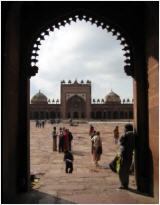Fatehpur Sikri
Fatehpur Sikri served as Akbars political capital from 1571 until 1585 when it was abandoned, ostensibly due to lack of water. It is regarded as the emperor's crowning architectural legacy and indeed there are no shortage of palaces, halls, and masjids to satisfy his creative and aesthetic impulses typical of Mughals.. Brilliant innovations in land revenue, coinage, military organisation, and provincial administration emerged from the Fatehpur Sikri years.
Fatehpur Sikri shared its imperial duties as a capital city with Agra, where a bulk of the arsenal, treasure hoards, and other reserves were kept at its' Red Fort for security. During times of crisis, the court, harem, and treasury could be removed to Agra, located 26 miles or less than a day's march.
The layout of the city shows a conscious attempt at producing rich spatial effects by the organisation of built forms around open spaces in interesting ways. Of particular note is the way in which shifts in axes occur as one moves along the city and the location of squares in important places with buildings forming a backdrop or envelope. Unlike other important Mughal cities (such as Shahjahanabad, which has a very formal planning), Fatehpur Sikri has aspects of informality and improvisation. Indeed, the newly constructed city bore a similarity to the movable imperial encampment also designed by Akbar.

